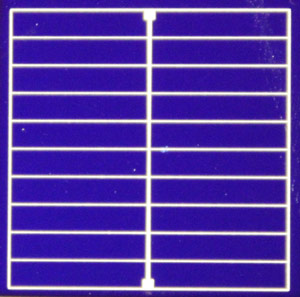
An international team of researchers working at the Molecular Foundry has simplified the steps to create highly efficient silicon solar cells by applying a new mix of materials to a standard design. Arrays of solar cells are used in solar panels to convert sunlight to electricity.
The special blend of materials—which could also prove useful in semiconductor components—eliminates the need for a process known as doping that steers the device’s properties by introducing foreign atoms to its electrical contacts. This doping process adds complexity to the device and can degrade its performance.
Crystalline silicon-based solar cells with doped contacts can exceed 20 percent efficiency—meaning more than 20 percent of the sun’s energy is converted to electricity. A dopant-free silicon cell had not previously exceeded 14 percent efficiency.
The new study, though, demonstrated a dopant-free silicon cell, referred to as a DASH cell (dopant free asymmetric heterocontact), with an average efficiency above 19 percent. This increased efficiency is a product of the use of new materials and a simple coating process on the top and bottom of the device. Researchers showed it’s possible to create their solar cell in just seven steps.

